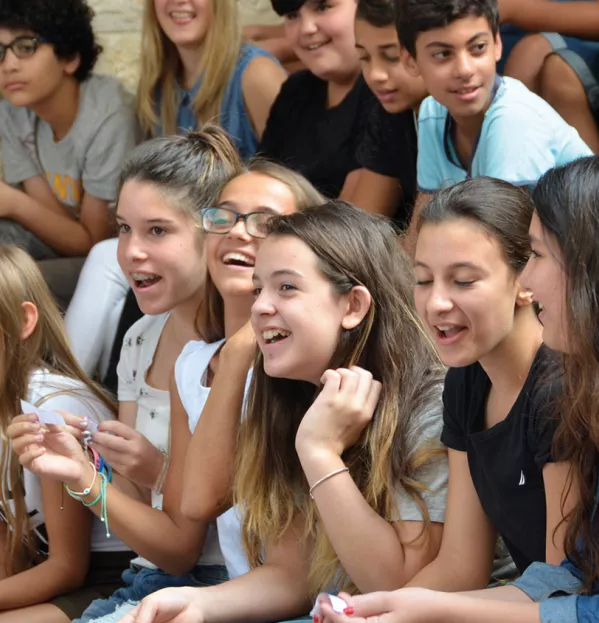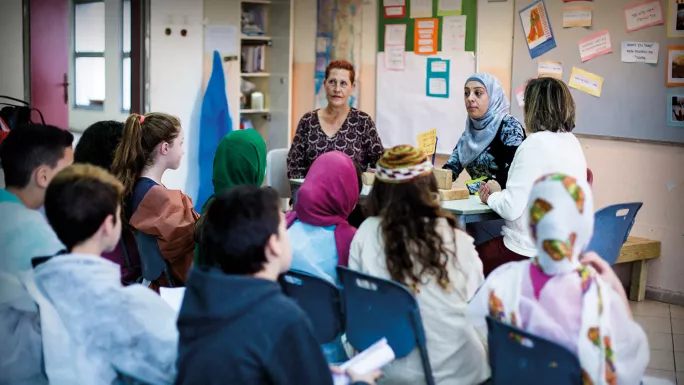
How bilingual teaching can break down barriers

“I had a ballet teacher,” says 16-year-old Inbar Shaked-Vardi. “When I talked to her about my school, about learning Arabic, she said, ‘When I hear Arabs talk on the train, I get so scared.’ “And I said, ‘No, no. They’re just talking about what to make for dinner’.”
Shaked-Vardi has been a pupil at the Hand in Hand school in Jerusalem since she was four years old. The founding premise of all Hand in Hand schools - there are now six in Israel - is equality. Jews and Arabs are taught together.
Each primary class is taught by two teachers, one Arab and one Jewish. Each lesson is conducted in both Arabic and Hebrew.
Better equipped
Around the world, increasing numbers are being taught in bilingual or trilingual schools. In some cases, this is because pupils’ native language is not spoken outside their country’s borders. In others, it is so that pupils are better equipped to participate in a global economy. Bilingualism, schools are realising, is a way to break down social and cultural barriers.
This is the case at Hand in Hand. Most schools in Israel tend to be divided along Arab-Jewish lines. Jewish pupils study in Jewish schools, where the medium of instruction is Hebrew. Arab pupils study in Arabic-medium schools. Bilingual education crosses this divide.
“People often think that, because we’re Jews and Arabs, that’s how our opinions are divided,” says Shaked-Vardi. “But there are a lot of opinions in our school. Sometimes Arabs and Jews agree, and other Arabs and Jews disagree.
“And, whatever we say, we’re all friends. Or some of us aren’t. It’s just a school.”
The first Hand in Hand schools - based in Jerusalem and in the Galilee - were established in 1998 by a coalition of Jewish and Arab parents. Back then, there were only 20 pupils in the Jerusalem school; this year, there are 697.
Sixty per cent of these pupils are Arab; 40 per cent are Jewish. (The school aims for a 50:50 ratio, but more Arabs than Jews tend to apply.)
My Jewish friends outside school think it’s strange I have Arab friends
It is funded in the same way as all schools in Israel, with a budget for one teacher for each class. The money for the second teacher comes from philanthropic donations.
Mimi Fakih speaks to her kindergarten class almost exclusively in Arabic; her co-teacher speaks entirely in Hebrew. On one wall are Arabic vowels; on the other are Hebrew words for family members. A calendar marks Jewish, Muslim and Christian religious festivals.

Fakih translates only when she can see a child struggling to understand. Her words, however, are accompanied by expansive body language.
“The children don’t get confused - they feel accomplished when they speak a sentence in their own language and then start adding words in the other language,” she says. “That’s how they start integrating the languages.”
Fakih comes from a liberal family in East Jerusalem. “In my family, a person is a person, no matter where they’re from,” she says.
She pauses. “But, when there’s violence - the stabbings in Jerusalem, the war in Gaza - they say, ‘Aren’t you afraid to send your kids to school with Jews?’ ”
Erecting checkpoints
On occasion, too, the Israeli army will close off areas of East Jerusalem, erecting checkpoints for Arabs wanting to come or go.
“Then, people say, ‘Israelis are making your life harder’,” Fakih says. “They say, ‘How can you mix with them?’ They don’t understand that they’re not one block of people, the Israelis.”
This lack of understanding goes both ways. “We’re Holocaust survivors, my family,” says art teacher Efrat Mayer. “I understood Holocaust history, European history, and Israeli history.
“But only when I came here did I understand the challenges of Palestinian society and history.”
Bilingualism plays a key role in breaking down this divide. At one point, an Arab teacher recounts what happened to her family in 1948, when the state of Israel was established.

At the end of the story, she pauses. “I’ve never told this story in Hebrew before,” she says. Similarly, Mayer has heard her grandmother’s Holocaust story recounted in Arabic.
Around the world, research has shown that pupils given immersive language lessons are more motivated to learn the language, and are more confident that they will be able to make practical use of it.
However, even a fully immersive school cannot shut out the outside world. At Hand in Hand, despite the teachers’ efforts, the two languages remain unequal.
“What we’d hoped would happen is that Jews would pick up Arabic, because they’d be immersed,” says teacher Yaffa Shira Grossberg. “It hasn’t happened as we hoped. Arabs pick up Hebrew faster, and get to a higher standard.”
Mixed groups of pupils tend to default to speaking Hebrew; even all-Arab groups speak a heavily Hebrew-inflected version of Arabic.

“I think the Arabs know Hebrew better than we know Arabic,” says Shaked-Vardi. “So sometimes conversations just go to Hebrew, because we don’t know a word or a sentence in Arabic.”
Next to her, 16-year-old Jewish pupil Leila Ben-Horin nods. “I try and go out and speak Arabic. A lot of people are surprised. My Jewish friends outside school - they think it’s strange I have Arab friends. Their normal life is going to school where most of the students are Jewish.”
Shaked-Vardi smiles. “There are definitely some people who think it’s weird,” she says. “Some of them definitely think it’s cool, that it’s a good thing. And some think you’re doing something wrong by cooperating with the - I don’t know - the enemy, really. That Arabs are all terrorists and they’re trying to kill us.”
But, says Ben-Horin, it is much harder to believe this once you understand Arabic. “I listen in on Arab conversations on the train and the bus. I understand what they’re saying, and I know they don’t think I understand them. They’re never saying anything interesting.”
You need a Tes subscription to read this article
Subscribe now to read this article and get other subscriber-only content:
- Unlimited access to all Tes magazine content
- Exclusive subscriber-only stories
- Award-winning email newsletters
- Unlimited access to all Tes magazine content
- Exclusive subscriber-only stories
- Award-winning email newsletters
You need a subscription to read this article
Subscribe now to read this article and get other subscriber-only content, including:
- Unlimited access to all Tes magazine content
- Exclusive subscriber-only stories
- Award-winning email newsletters
- Unlimited access to all Tes magazine content
- Exclusive subscriber-only stories
- Award-winning email newsletters